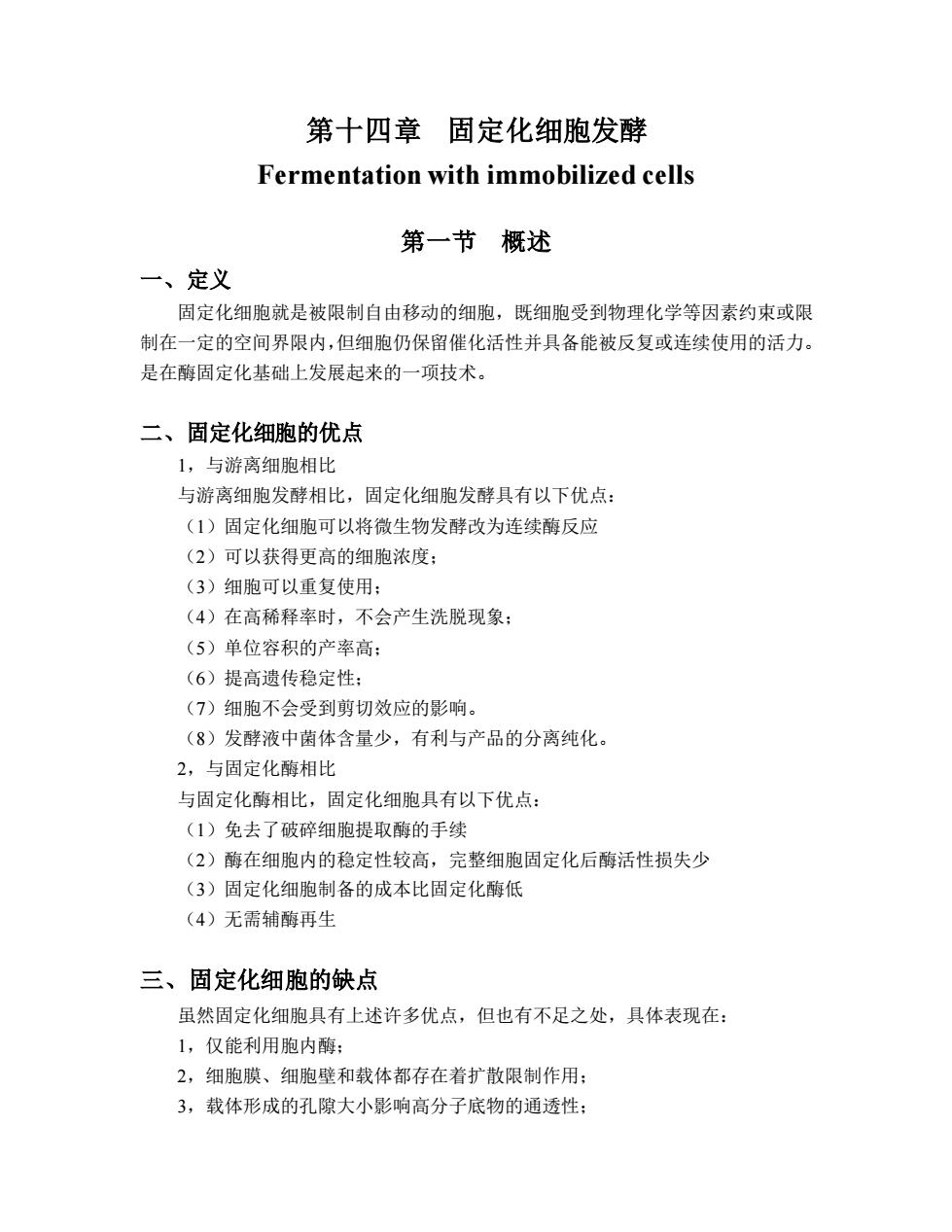
第十四章 固定化细胞发酵 Fermentation with immobilized cells 第一节 概述 一、定义 固定化细胞就是被限制自由移动的细胞,既细胞受到物理化学等因素约束或限 制在一定的空间界限内,但细胞仍保留催化活性并具备能被反复或连续使用的活力。 是在酶固定化基础上发展起来的一项技术。 二、固定化细胞的优点 1,与游离细胞相比 与游离细胞发酵相比,固定化细胞发酵具有以下优点: (1)固定化细胞可以将微生物发酵改为连续酶反应 (2)可以获得更高的细胞浓度; (3)细胞可以重复使用; (4)在高稀释率时,不会产生洗脱现象; (5)单位容积的产率高; (6)提高遗传稳定性; (7)细胞不会受到剪切效应的影响。 (8)发酵液中菌体含量少,有利与产品的分离纯化。 2,与固定化酶相比 与固定化酶相比,固定化细胞具有以下优点: (1)免去了破碎细胞提取酶的手续 (2)酶在细胞内的稳定性较高,完整细胞固定化后酶活性损失少 (3)固定化细胞制备的成本比固定化酶低 (4)无需辅酶再生 三、固定化细胞的缺点 虽然固定化细胞具有上述许多优点,但也有不足之处,具体表现在: 1,仅能利用胞内酶; 2,细胞膜、细胞壁和载体都存在着扩散限制作用; 3,载体形成的孔隙大小影响高分子底物的通透性;
第十四章 固定化细胞发酵 Fermentation with immobilized cells 第一节 概述 一、定义 固定化细胞就是被限制自由移动的细胞,既细胞受到物理化学等因素约束或限 制在一定的空间界限内,但细胞仍保留催化活性并具备能被反复或连续使用的活力。 是在酶固定化基础上发展起来的一项技术。 二、固定化细胞的优点 1,与游离细胞相比 与游离细胞发酵相比,固定化细胞发酵具有以下优点: (1)固定化细胞可以将微生物发酵改为连续酶反应 (2)可以获得更高的细胞浓度; (3)细胞可以重复使用; (4)在高稀释率时,不会产生洗脱现象; (5)单位容积的产率高; (6)提高遗传稳定性; (7)细胞不会受到剪切效应的影响。 (8)发酵液中菌体含量少,有利与产品的分离纯化。 2,与固定化酶相比 与固定化酶相比,固定化细胞具有以下优点: (1)免去了破碎细胞提取酶的手续 (2)酶在细胞内的稳定性较高,完整细胞固定化后酶活性损失少 (3)固定化细胞制备的成本比固定化酶低 (4)无需辅酶再生 三、固定化细胞的缺点 虽然固定化细胞具有上述许多优点,但也有不足之处,具体表现在: 1,仅能利用胞内酶; 2,细胞膜、细胞壁和载体都存在着扩散限制作用; 3,载体形成的孔隙大小影响高分子底物的通透性;

4,可能有副反应。 四、固定化细胞的分类 1,按固定的细胞类型不同分为三类: (1)微生物; (2)动物; (3)植物。 2,按细胞的生理状态不同分为两大类: (1)死细胞:包括完整细胞、细胞碎片、细胞器。适用于一种酶催化的反应。 (2)活细胞:包括增殖细胞、静止细胞、饥饿细胞。适用于多酶反应,特别是 需要辅酶的反应。 第二节 细胞固定化的方法 细胞固定化方法有:Adsorption(吸附);covalent bonding(共价结合); Cross linking(交联);Entrapment(包埋)、Encapsulation(微胶囊) 。下面对这几 种做具体介绍。 一、吸附法 1,原理 利用载体和细胞表面所带电荷的静电引力(van der Walls forces),使细胞吸附 于载体上。吸附法可分为物理吸附和离子吸附两种。该法操作简单,固定化过程对 细胞活性影响小。 2,载体的材料 采用吸附法固定细胞,所用的载体主要有:硅藻土、木屑、多孔玻璃、活性炭、 多孔陶瓷、离子交换树脂和等。塑料 3,影响吸附固定化的因素 (1)Z-电位 (2)细胞的性质和细胞壁的组成 (3)载体的性质 (4)pH 二、共价结合法 利用细胞表面的反应基团(如氨基、羧基、羟基、巯基、咪唑基)与活化的无
4,可能有副反应。 四、固定化细胞的分类 1,按固定的细胞类型不同分为三类: (1)微生物; (2)动物; (3)植物。 2,按细胞的生理状态不同分为两大类: (1)死细胞:包括完整细胞、细胞碎片、细胞器。适用于一种酶催化的反应。 (2)活细胞:包括增殖细胞、静止细胞、饥饿细胞。适用于多酶反应,特别是 需要辅酶的反应。 第二节 细胞固定化的方法 细胞固定化方法有:Adsorption(吸附);covalent bonding(共价结合); Cross linking(交联);Entrapment(包埋)、Encapsulation(微胶囊) 。下面对这几 种做具体介绍。 一、吸附法 1,原理 利用载体和细胞表面所带电荷的静电引力(van der Walls forces),使细胞吸附 于载体上。吸附法可分为物理吸附和离子吸附两种。该法操作简单,固定化过程对 细胞活性影响小。 2,载体的材料 采用吸附法固定细胞,所用的载体主要有:硅藻土、木屑、多孔玻璃、活性炭、 多孔陶瓷、离子交换树脂和等。塑料 3,影响吸附固定化的因素 (1)Z-电位 (2)细胞的性质和细胞壁的组成 (3)载体的性质 (4)pH 二、共价结合法 利用细胞表面的反应基团(如氨基、羧基、羟基、巯基、咪唑基)与活化的无
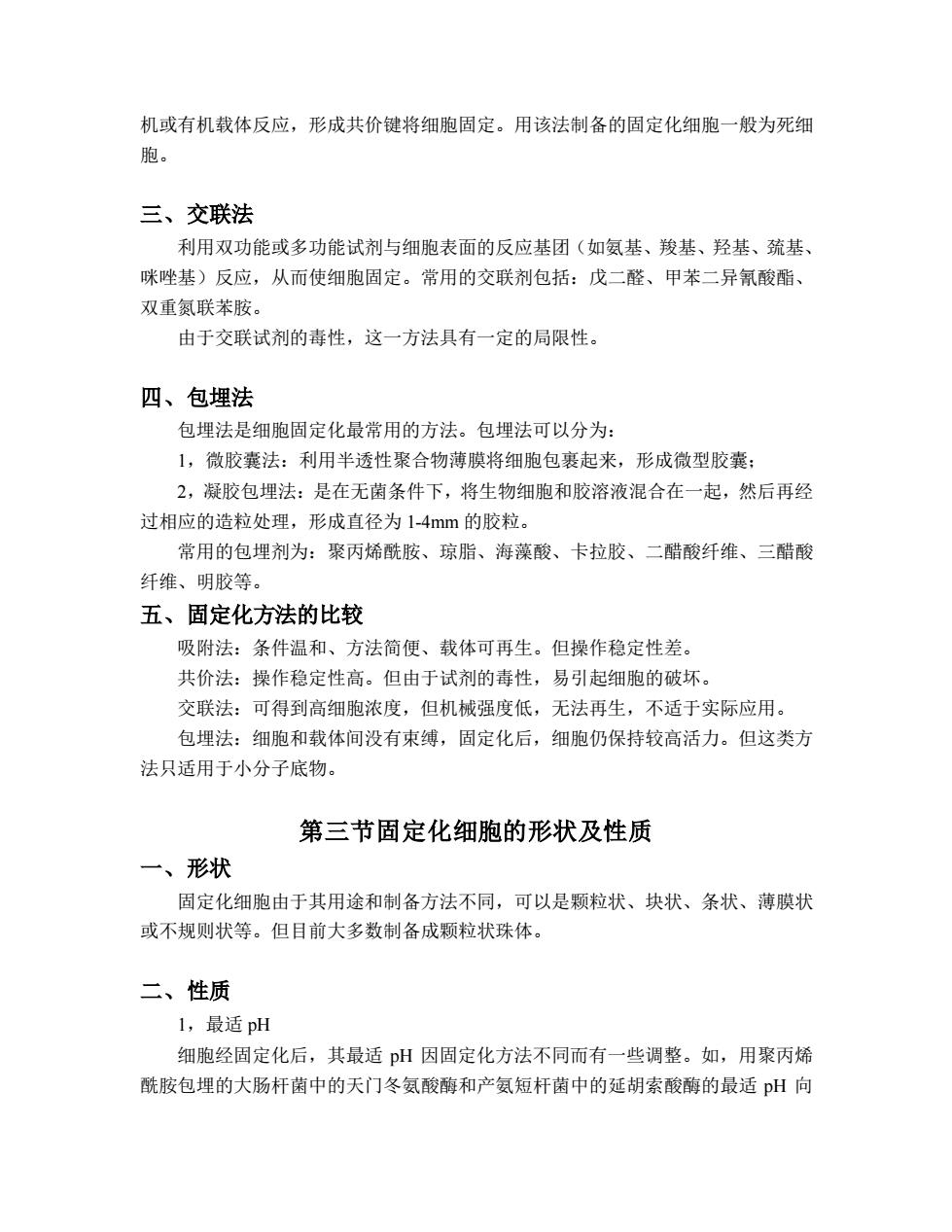
机或有机载体反应,形成共价键将细胞固定。用该法制备的固定化细胞一般为死细 胞。 三、交联法 利用双功能或多功能试剂与细胞表面的反应基团(如氨基、羧基、羟基、巯基、 咪唑基)反应,从而使细胞固定。常用的交联剂包括:戊二醛、甲苯二异氰酸酯、 双重氮联苯胺。 由于交联试剂的毒性,这一方法具有一定的局限性。 四、包埋法 包埋法是细胞固定化最常用的方法。包埋法可以分为: 1,微胶囊法:利用半透性聚合物薄膜将细胞包裹起来,形成微型胶囊; 2,凝胶包埋法:是在无菌条件下,将生物细胞和胶溶液混合在一起,然后再经 过相应的造粒处理,形成直径为 1-4mm 的胶粒。 常用的包埋剂为:聚丙烯酰胺、琼脂、海藻酸、卡拉胶、二醋酸纤维、三醋酸 纤维、明胶等。 五、固定化方法的比较 吸附法:条件温和、方法简便、载体可再生。但操作稳定性差。 共价法:操作稳定性高。但由于试剂的毒性,易引起细胞的破坏。 交联法:可得到高细胞浓度,但机械强度低,无法再生,不适于实际应用。 包埋法:细胞和载体间没有束缚,固定化后,细胞仍保持较高活力。但这类方 法只适用于小分子底物。 第三节固定化细胞的形状及性质 一、形状 固定化细胞由于其用途和制备方法不同,可以是颗粒状、块状、条状、薄膜状 或不规则状等。但目前大多数制备成颗粒状珠体。 二、性质 1,最适 pH 细胞经固定化后,其最适 pH 因固定化方法不同而有一些调整。如,用聚丙烯 酰胺包埋的大肠杆菌中的天门冬氨酸酶和产氨短杆菌中的延胡索酸酶的最适 pH 向
机或有机载体反应,形成共价键将细胞固定。用该法制备的固定化细胞一般为死细 胞。 三、交联法 利用双功能或多功能试剂与细胞表面的反应基团(如氨基、羧基、羟基、巯基、 咪唑基)反应,从而使细胞固定。常用的交联剂包括:戊二醛、甲苯二异氰酸酯、 双重氮联苯胺。 由于交联试剂的毒性,这一方法具有一定的局限性。 四、包埋法 包埋法是细胞固定化最常用的方法。包埋法可以分为: 1,微胶囊法:利用半透性聚合物薄膜将细胞包裹起来,形成微型胶囊; 2,凝胶包埋法:是在无菌条件下,将生物细胞和胶溶液混合在一起,然后再经 过相应的造粒处理,形成直径为 1-4mm 的胶粒。 常用的包埋剂为:聚丙烯酰胺、琼脂、海藻酸、卡拉胶、二醋酸纤维、三醋酸 纤维、明胶等。 五、固定化方法的比较 吸附法:条件温和、方法简便、载体可再生。但操作稳定性差。 共价法:操作稳定性高。但由于试剂的毒性,易引起细胞的破坏。 交联法:可得到高细胞浓度,但机械强度低,无法再生,不适于实际应用。 包埋法:细胞和载体间没有束缚,固定化后,细胞仍保持较高活力。但这类方 法只适用于小分子底物。 第三节固定化细胞的形状及性质 一、形状 固定化细胞由于其用途和制备方法不同,可以是颗粒状、块状、条状、薄膜状 或不规则状等。但目前大多数制备成颗粒状珠体。 二、性质 1,最适 pH 细胞经固定化后,其最适 pH 因固定化方法不同而有一些调整。如,用聚丙烯 酰胺包埋的大肠杆菌中的天门冬氨酸酶和产氨短杆菌中的延胡索酸酶的最适 pH 向
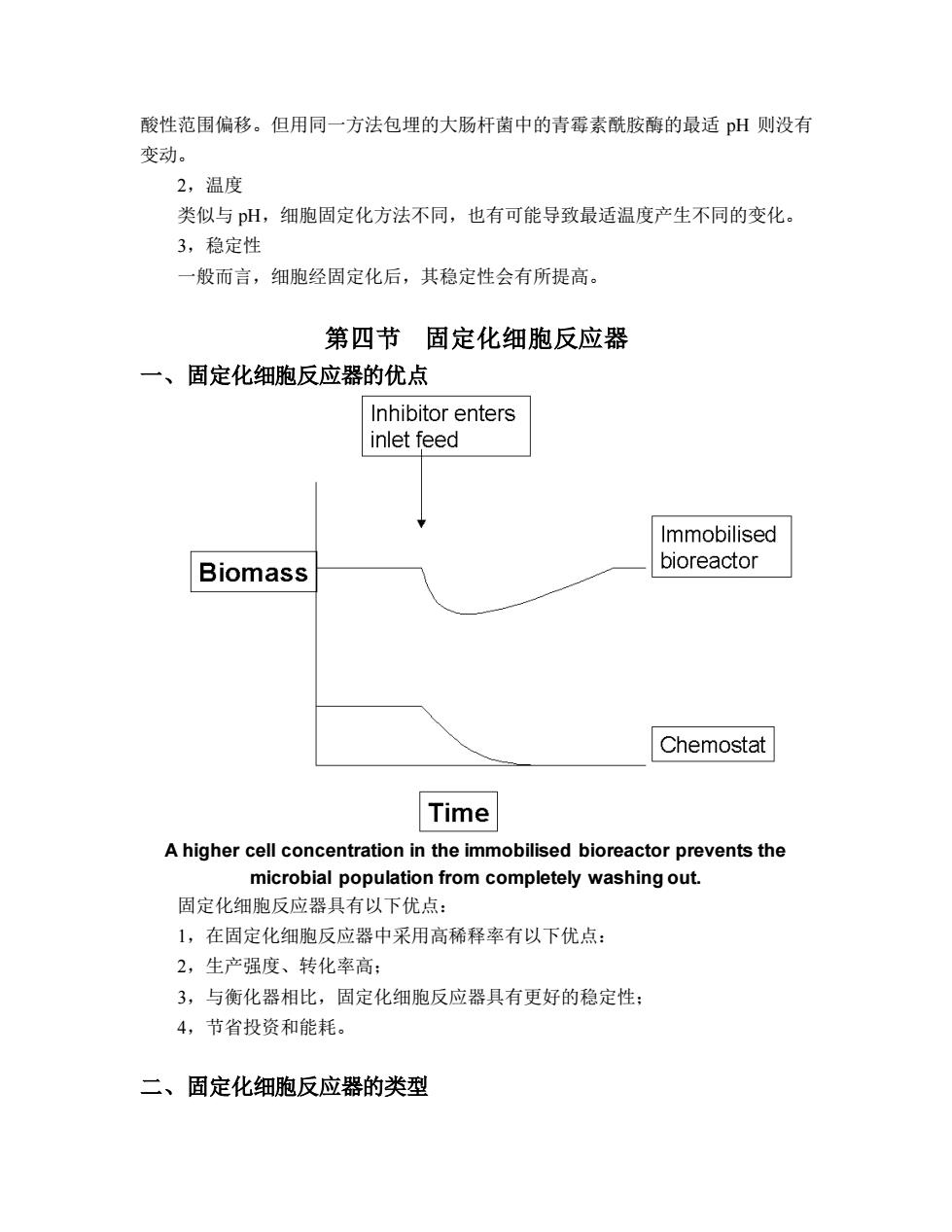
酸性范围偏移。但用同一方法包埋的大肠杆菌中的青霉素酰胺酶的最适 pH 则没有 变动。 2,温度 类似与 pH,细胞固定化方法不同,也有可能导致最适温度产生不同的变化。 3,稳定性 一般而言,细胞经固定化后,其稳定性会有所提高。 第四节 固定化细胞反应器 一、固定化细胞反应器的优点 A higher cell concentration in the immobilised bioreactor prevents the microbial population from completely washing out. 固定化细胞反应器具有以下优点: 1,在固定化细胞反应器中采用高稀释率有以下优点: 2,生产强度、转化率高; 3,与衡化器相比,固定化细胞反应器具有更好的稳定性; 4,节省投资和能耗。 二、固定化细胞反应器的类型
酸性范围偏移。但用同一方法包埋的大肠杆菌中的青霉素酰胺酶的最适 pH 则没有 变动。 2,温度 类似与 pH,细胞固定化方法不同,也有可能导致最适温度产生不同的变化。 3,稳定性 一般而言,细胞经固定化后,其稳定性会有所提高。 第四节 固定化细胞反应器 一、固定化细胞反应器的优点 A higher cell concentration in the immobilised bioreactor prevents the microbial population from completely washing out. 固定化细胞反应器具有以下优点: 1,在固定化细胞反应器中采用高稀释率有以下优点: 2,生产强度、转化率高; 3,与衡化器相比,固定化细胞反应器具有更好的稳定性; 4,节省投资和能耗。 二、固定化细胞反应器的类型
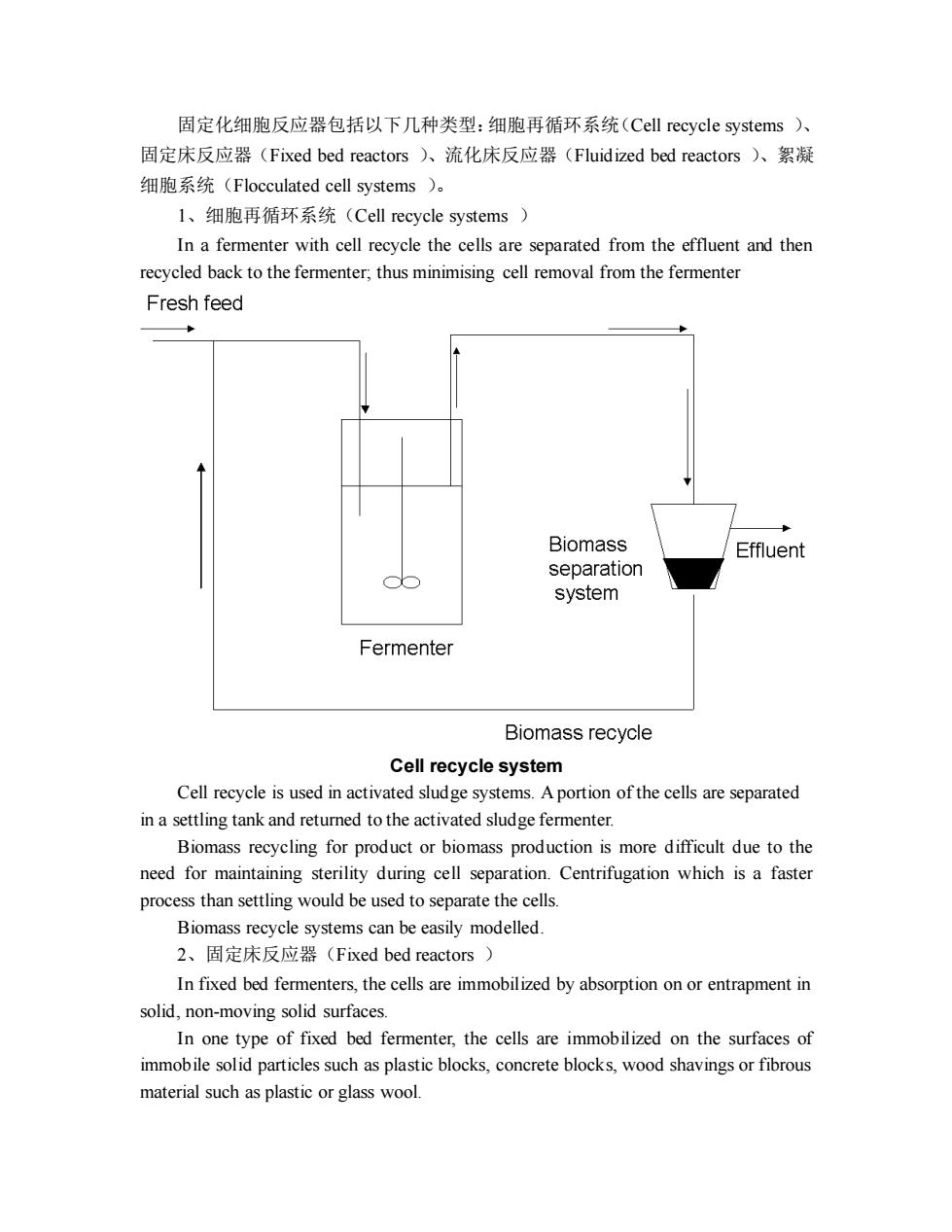
固定化细胞反应器包括以下几种类型:细胞再循环系统(Cell recycle systems )、 固定床反应器(Fixed bed reactors )、流化床反应器(Fluidized bed reactors )、絮凝 细胞系统(Flocculated cell systems )。 1、细胞再循环系统(Cell recycle systems ) In a fermenter with cell recycle the cells are separated from the effluent and then recycled back to the fermenter; thus minimising cell removal from the fermenter Cell recycle system Cell recycle is used in activated sludge systems. A portion of the cells are separated in a settling tank and returned to the activated sludge fermenter. Biomass recycling for product or biomass production is more difficult due to the need for maintaining sterility during cell separation. Centrifugation which is a faster process than settling would be used to separate the cells. Biomass recycle systems can be easily modelled. 2、固定床反应器(Fixed bed reactors ) In fixed bed fermenters, the cells are immobilized by absorption on or entrapment in solid, non-moving solid surfaces. In one type of fixed bed fermenter, the cells are immobilized on the surfaces of immobile solid particles such as plastic blocks, concrete blocks, wood shavings or fibrous material such as plastic or glass wool
固定化细胞反应器包括以下几种类型:细胞再循环系统(Cell recycle systems )、 固定床反应器(Fixed bed reactors )、流化床反应器(Fluidized bed reactors )、絮凝 细胞系统(Flocculated cell systems )。 1、细胞再循环系统(Cell recycle systems ) In a fermenter with cell recycle the cells are separated from the effluent and then recycled back to the fermenter; thus minimising cell removal from the fermenter Cell recycle system Cell recycle is used in activated sludge systems. A portion of the cells are separated in a settling tank and returned to the activated sludge fermenter. Biomass recycling for product or biomass production is more difficult due to the need for maintaining sterility during cell separation. Centrifugation which is a faster process than settling would be used to separate the cells. Biomass recycle systems can be easily modelled. 2、固定床反应器(Fixed bed reactors ) In fixed bed fermenters, the cells are immobilized by absorption on or entrapment in solid, non-moving solid surfaces. In one type of fixed bed fermenter, the cells are immobilized on the surfaces of immobile solid particles such as plastic blocks, concrete blocks, wood shavings or fibrous material such as plastic or glass wool
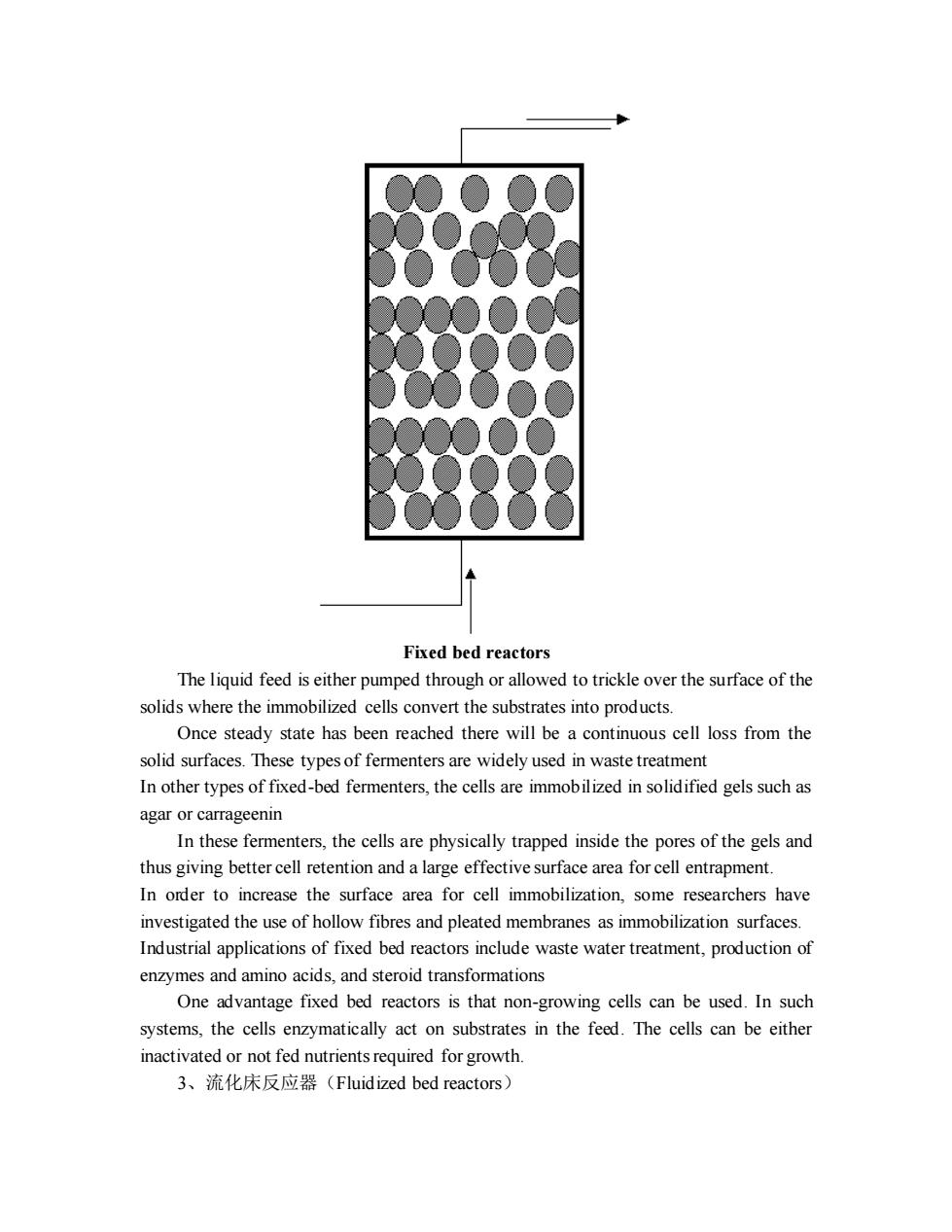
Fixed bed reactors The liquid feed is either pumped through or allowed to trickle over the surface of the solids where the immobilized cells convert the substrates into products. Once steady state has been reached there will be a continuous cell loss from the solid surfaces. These types of fermenters are widely used in waste treatment In other types of fixed-bed fermenters, the cells are immobilized in solidified gels such as agar or carrageenin In these fermenters, the cells are physically trapped inside the pores of the gels and thus giving better cell retention and a large effective surface area for cell entrapment. In order to increase the surface area for cell immobilization, some researchers have investigated the use of hollow fibres and pleated membranes as immobilization surfaces. Industrial applications of fixed bed reactors include waste water treatment, production of enzymes and amino acids, and steroid transformations One advantage fixed bed reactors is that non-growing cells can be used. In such systems, the cells enzymatically act on substrates in the feed. The cells can be either inactivated or not fed nutrients required for growth. 3、流化床反应器(Fluidized bed reactors)
Fixed bed reactors The liquid feed is either pumped through or allowed to trickle over the surface of the solids where the immobilized cells convert the substrates into products. Once steady state has been reached there will be a continuous cell loss from the solid surfaces. These types of fermenters are widely used in waste treatment In other types of fixed-bed fermenters, the cells are immobilized in solidified gels such as agar or carrageenin In these fermenters, the cells are physically trapped inside the pores of the gels and thus giving better cell retention and a large effective surface area for cell entrapment. In order to increase the surface area for cell immobilization, some researchers have investigated the use of hollow fibres and pleated membranes as immobilization surfaces. Industrial applications of fixed bed reactors include waste water treatment, production of enzymes and amino acids, and steroid transformations One advantage fixed bed reactors is that non-growing cells can be used. In such systems, the cells enzymatically act on substrates in the feed. The cells can be either inactivated or not fed nutrients required for growth. 3、流化床反应器(Fluidized bed reactors)
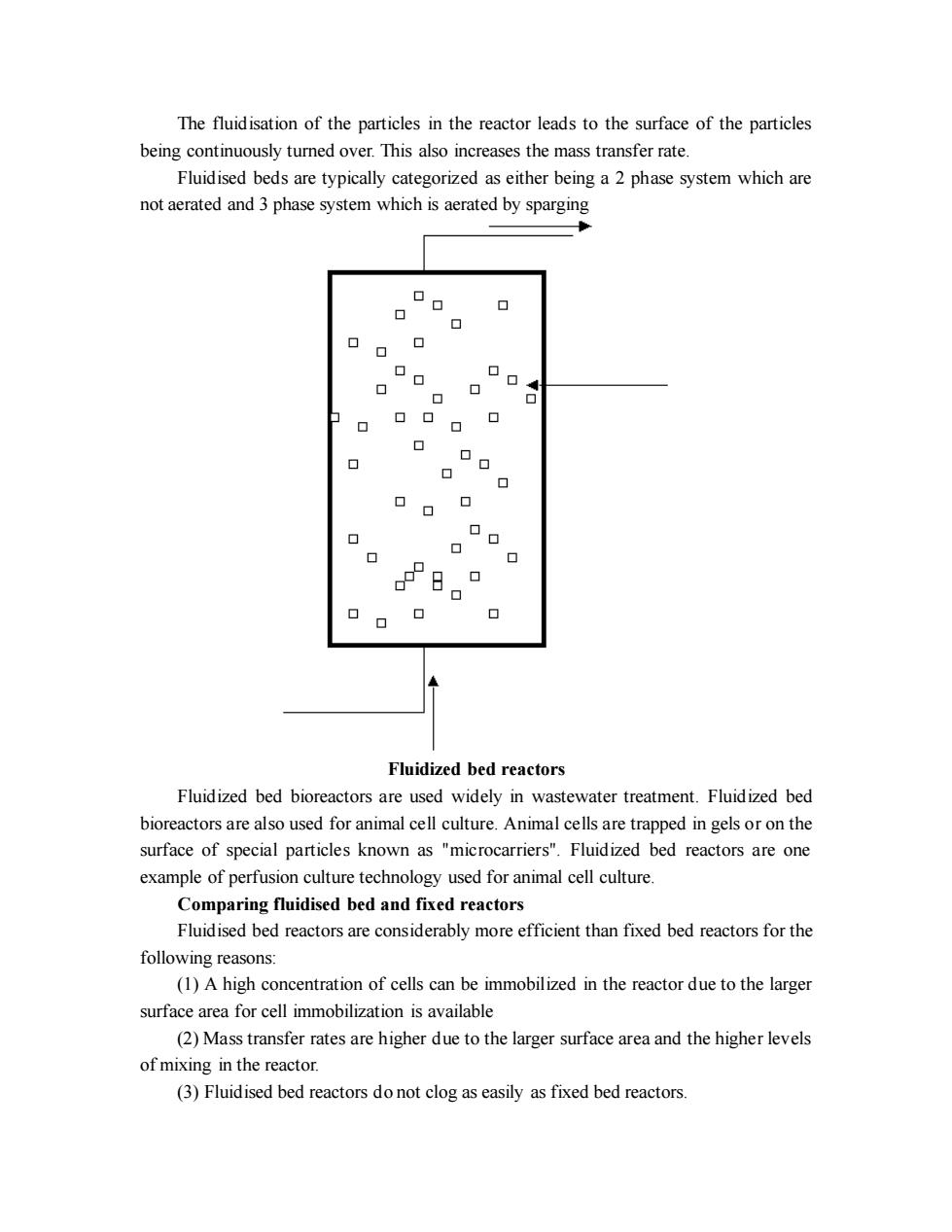
The fluidisation of the particles in the reactor leads to the surface of the particles being continuously turned over. This also increases the mass transfer rate. Fluidised beds are typically categorized as either being a 2 phase system which are not aerated and 3 phase system which is aerated by sparging Fluidized bed reactors Fluidized bed bioreactors are used widely in wastewater treatment. Fluidized bed bioreactors are also used for animal cell culture. Animal cells are trapped in gels or on the surface of special particles known as "microcarriers". Fluidized bed reactors are one example of perfusion culture technology used for animal cell culture. Comparing fluidised bed and fixed reactors Fluidised bed reactors are considerably more efficient than fixed bed reactors for the following reasons: (1) A high concentration of cells can be immobilized in the reactor due to the larger surface area for cell immobilization is available (2) Mass transfer rates are higher due to the larger surface area and the higher levels of mixing in the reactor. (3) Fluidised bed reactors do not clog as easily as fixed bed reactors
The fluidisation of the particles in the reactor leads to the surface of the particles being continuously turned over. This also increases the mass transfer rate. Fluidised beds are typically categorized as either being a 2 phase system which are not aerated and 3 phase system which is aerated by sparging Fluidized bed reactors Fluidized bed bioreactors are used widely in wastewater treatment. Fluidized bed bioreactors are also used for animal cell culture. Animal cells are trapped in gels or on the surface of special particles known as "microcarriers". Fluidized bed reactors are one example of perfusion culture technology used for animal cell culture. Comparing fluidised bed and fixed reactors Fluidised bed reactors are considerably more efficient than fixed bed reactors for the following reasons: (1) A high concentration of cells can be immobilized in the reactor due to the larger surface area for cell immobilization is available (2) Mass transfer rates are higher due to the larger surface area and the higher levels of mixing in the reactor. (3) Fluidised bed reactors do not clog as easily as fixed bed reactors
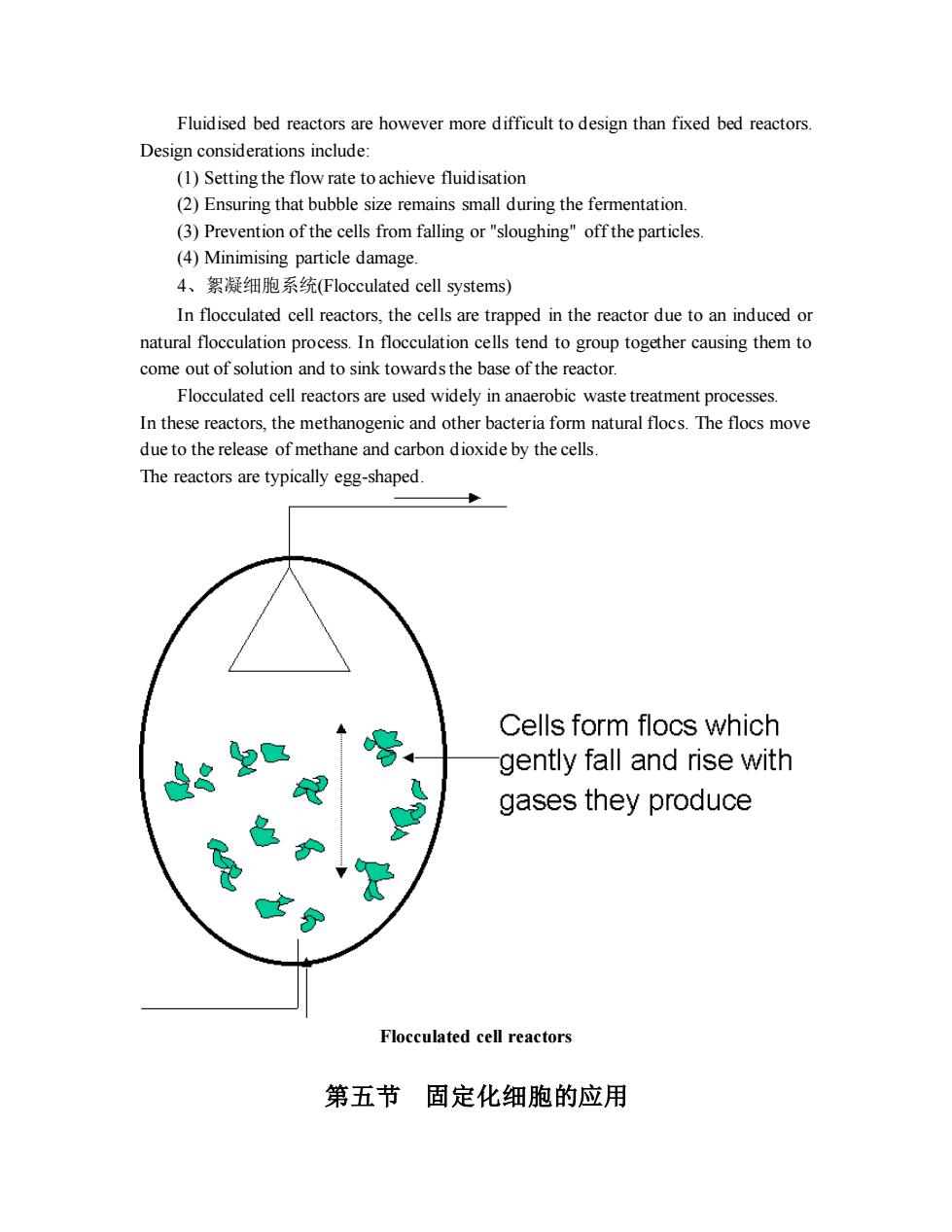
Fluidised bed reactors are however more difficult to design than fixed bed reactors. Design considerations include: (1) Setting the flow rate to achieve fluidisation (2) Ensuring that bubble size remains small during the fermentation. (3) Prevention of the cells from falling or "sloughing" off the particles. (4) Minimising particle damage. 4、絮凝细胞系统(Flocculated cell systems) In flocculated cell reactors, the cells are trapped in the reactor due to an induced or natural flocculation process. In flocculation cells tend to group together causing them to come out of solution and to sink towards the base of the reactor. Flocculated cell reactors are used widely in anaerobic waste treatment processes. In these reactors, the methanogenic and other bacteria form natural flocs. The flocs move due to the release of methane and carbon dioxide by the cells. The reactors are typically egg-shaped. Flocculated cell reactors 第五节 固定化细胞的应用
Fluidised bed reactors are however more difficult to design than fixed bed reactors. Design considerations include: (1) Setting the flow rate to achieve fluidisation (2) Ensuring that bubble size remains small during the fermentation. (3) Prevention of the cells from falling or "sloughing" off the particles. (4) Minimising particle damage. 4、絮凝细胞系统(Flocculated cell systems) In flocculated cell reactors, the cells are trapped in the reactor due to an induced or natural flocculation process. In flocculation cells tend to group together causing them to come out of solution and to sink towards the base of the reactor. Flocculated cell reactors are used widely in anaerobic waste treatment processes. In these reactors, the methanogenic and other bacteria form natural flocs. The flocs move due to the release of methane and carbon dioxide by the cells. The reactors are typically egg-shaped. Flocculated cell reactors 第五节 固定化细胞的应用
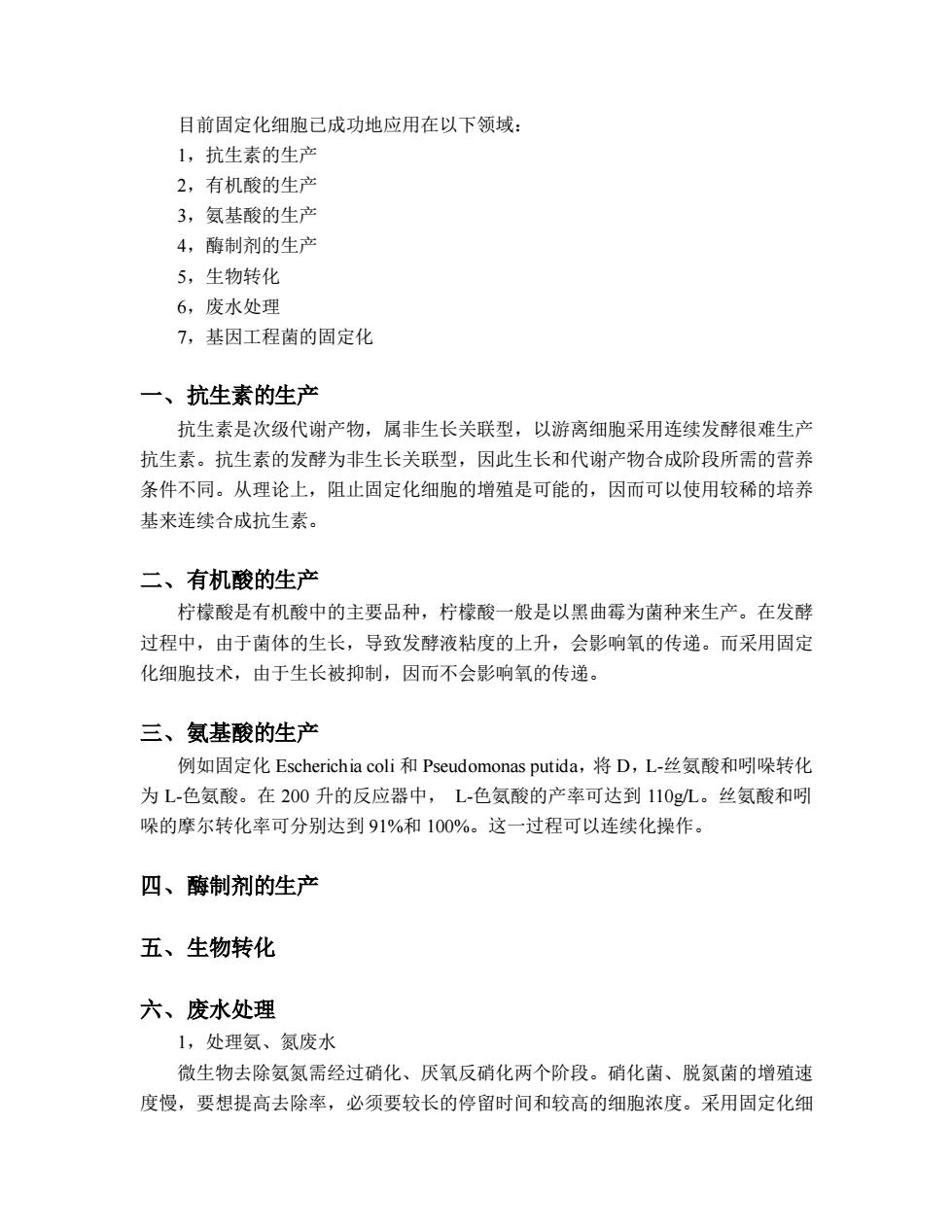
目前固定化细胞已成功地应用在以下领域: 1,抗生素的生产 2,有机酸的生产 3,氨基酸的生产 4,酶制剂的生产 5,生物转化 6,废水处理 7,基因工程菌的固定化 一、抗生素的生产 抗生素是次级代谢产物,属非生长关联型,以游离细胞采用连续发酵很难生产 抗生素。抗生素的发酵为非生长关联型,因此生长和代谢产物合成阶段所需的营养 条件不同。从理论上,阻止固定化细胞的增殖是可能的,因而可以使用较稀的培养 基来连续合成抗生素。 二、有机酸的生产 柠檬酸是有机酸中的主要品种,柠檬酸一般是以黑曲霉为菌种来生产。在发酵 过程中,由于菌体的生长,导致发酵液粘度的上升,会影响氧的传递。而采用固定 化细胞技术,由于生长被抑制,因而不会影响氧的传递。 三、氨基酸的生产 例如固定化 Escherichia coli 和 Pseudomonas putida,将 D,L-丝氨酸和吲哚转化 为 L-色氨酸。在 200 升的反应器中, L-色氨酸的产率可达到 110g/L。丝氨酸和吲 哚的摩尔转化率可分别达到 91%和 100%。这一过程可以连续化操作。 四、酶制剂的生产 五、生物转化 六、废水处理 1,处理氨、氮废水 微生物去除氨氮需经过硝化、厌氧反硝化两个阶段。硝化菌、脱氮菌的增殖速 度慢,要想提高去除率,必须要较长的停留时间和较高的细胞浓度。采用固定化细
目前固定化细胞已成功地应用在以下领域: 1,抗生素的生产 2,有机酸的生产 3,氨基酸的生产 4,酶制剂的生产 5,生物转化 6,废水处理 7,基因工程菌的固定化 一、抗生素的生产 抗生素是次级代谢产物,属非生长关联型,以游离细胞采用连续发酵很难生产 抗生素。抗生素的发酵为非生长关联型,因此生长和代谢产物合成阶段所需的营养 条件不同。从理论上,阻止固定化细胞的增殖是可能的,因而可以使用较稀的培养 基来连续合成抗生素。 二、有机酸的生产 柠檬酸是有机酸中的主要品种,柠檬酸一般是以黑曲霉为菌种来生产。在发酵 过程中,由于菌体的生长,导致发酵液粘度的上升,会影响氧的传递。而采用固定 化细胞技术,由于生长被抑制,因而不会影响氧的传递。 三、氨基酸的生产 例如固定化 Escherichia coli 和 Pseudomonas putida,将 D,L-丝氨酸和吲哚转化 为 L-色氨酸。在 200 升的反应器中, L-色氨酸的产率可达到 110g/L。丝氨酸和吲 哚的摩尔转化率可分别达到 91%和 100%。这一过程可以连续化操作。 四、酶制剂的生产 五、生物转化 六、废水处理 1,处理氨、氮废水 微生物去除氨氮需经过硝化、厌氧反硝化两个阶段。硝化菌、脱氮菌的增殖速 度慢,要想提高去除率,必须要较长的停留时间和较高的细胞浓度。采用固定化细
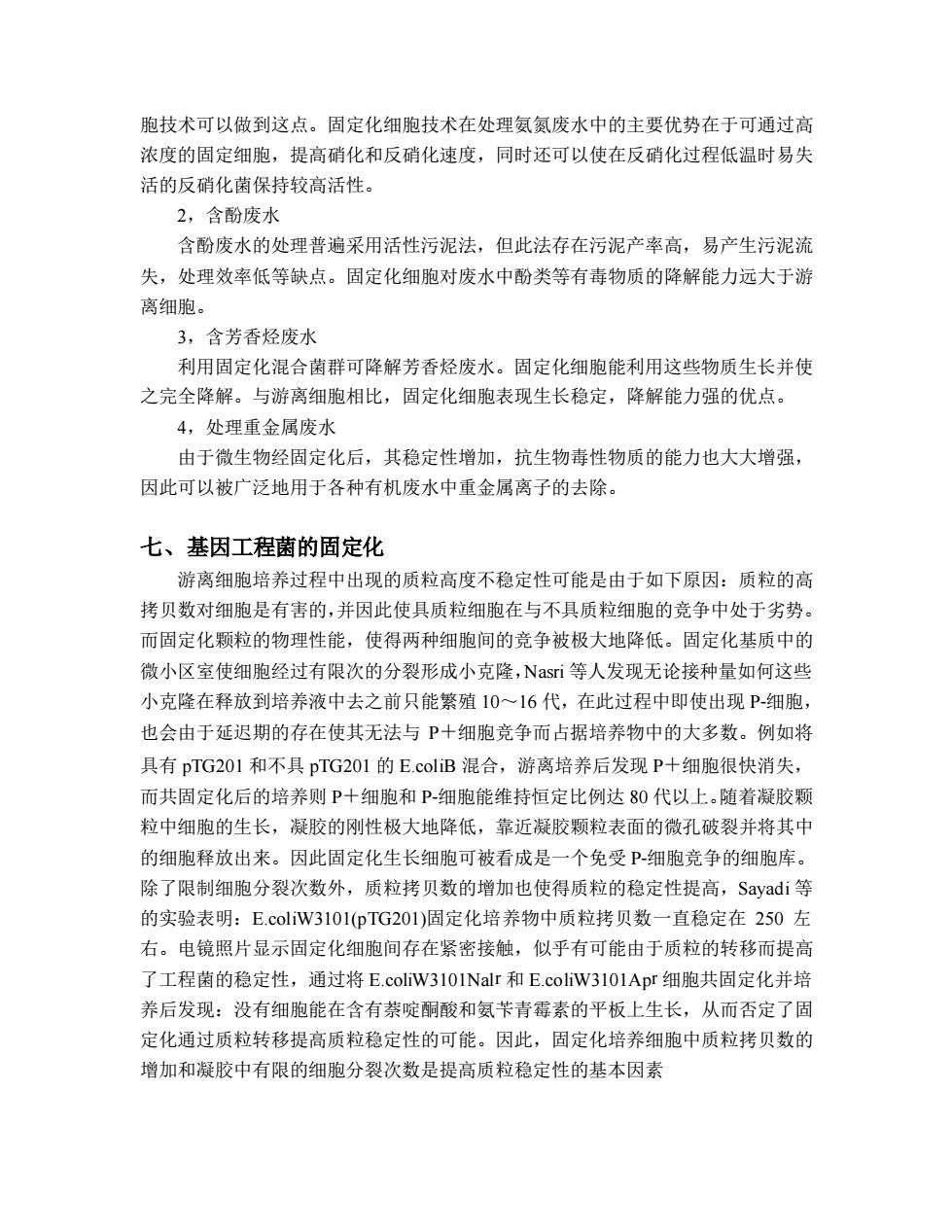
胞技术可以做到这点。固定化细胞技术在处理氨氮废水中的主要优势在于可通过高 浓度的固定细胞,提高硝化和反硝化速度,同时还可以使在反硝化过程低温时易失 活的反硝化菌保持较高活性。 2,含酚废水 含酚废水的处理普遍采用活性污泥法,但此法存在污泥产率高,易产生污泥流 失,处理效率低等缺点。固定化细胞对废水中酚类等有毒物质的降解能力远大于游 离细胞。 3,含芳香烃废水 利用固定化混合菌群可降解芳香烃废水。固定化细胞能利用这些物质生长并使 之完全降解。与游离细胞相比,固定化细胞表现生长稳定,降解能力强的优点。 4,处理重金属废水 由于微生物经固定化后,其稳定性增加,抗生物毒性物质的能力也大大增强, 因此可以被广泛地用于各种有机废水中重金属离子的去除。 七、基因工程菌的固定化 游离细胞培养过程中出现的质粒高度不稳定性可能是由于如下原因:质粒的高 拷贝数对细胞是有害的,并因此使具质粒细胞在与不具质粒细胞的竞争中处于劣势。 而固定化颗粒的物理性能,使得两种细胞间的竞争被极大地降低。固定化基质中的 微小区室使细胞经过有限次的分裂形成小克隆,Nasri 等人发现无论接种量如何这些 小克隆在释放到培养液中去之前只能繁殖 10~16 代,在此过程中即使出现 P-细胞, 也会由于延迟期的存在使其无法与 P+细胞竞争而占据培养物中的大多数。例如将 具有 pTG201 和不具 pTG201 的 E.coliB 混合,游离培养后发现 P+细胞很快消失, 而共固定化后的培养则 P+细胞和 P-细胞能维持恒定比例达 80 代以上。随着凝胶颗 粒中细胞的生长,凝胶的刚性极大地降低,靠近凝胶颗粒表面的微孔破裂并将其中 的细胞释放出来。因此固定化生长细胞可被看成是一个免受 P-细胞竞争的细胞库。 除了限制细胞分裂次数外,质粒拷贝数的增加也使得质粒的稳定性提高,Sayadi 等 的实验表明:E.coliW3101(pTG201)固定化培养物中质粒拷贝数一直稳定在 250 左 右。电镜照片显示固定化细胞间存在紧密接触,似乎有可能由于质粒的转移而提高 了工程菌的稳定性,通过将 E.coliW3101Nalr 和 E.coliW3101Apr 细胞共固定化并培 养后发现:没有细胞能在含有萘啶酮酸和氨苄青霉素的平板上生长,从而否定了固 定化通过质粒转移提高质粒稳定性的可能。因此,固定化培养细胞中质粒拷贝数的 增加和凝胶中有限的细胞分裂次数是提高质粒稳定性的基本因素
胞技术可以做到这点。固定化细胞技术在处理氨氮废水中的主要优势在于可通过高 浓度的固定细胞,提高硝化和反硝化速度,同时还可以使在反硝化过程低温时易失 活的反硝化菌保持较高活性。 2,含酚废水 含酚废水的处理普遍采用活性污泥法,但此法存在污泥产率高,易产生污泥流 失,处理效率低等缺点。固定化细胞对废水中酚类等有毒物质的降解能力远大于游 离细胞。 3,含芳香烃废水 利用固定化混合菌群可降解芳香烃废水。固定化细胞能利用这些物质生长并使 之完全降解。与游离细胞相比,固定化细胞表现生长稳定,降解能力强的优点。 4,处理重金属废水 由于微生物经固定化后,其稳定性增加,抗生物毒性物质的能力也大大增强, 因此可以被广泛地用于各种有机废水中重金属离子的去除。 七、基因工程菌的固定化 游离细胞培养过程中出现的质粒高度不稳定性可能是由于如下原因:质粒的高 拷贝数对细胞是有害的,并因此使具质粒细胞在与不具质粒细胞的竞争中处于劣势。 而固定化颗粒的物理性能,使得两种细胞间的竞争被极大地降低。固定化基质中的 微小区室使细胞经过有限次的分裂形成小克隆,Nasri 等人发现无论接种量如何这些 小克隆在释放到培养液中去之前只能繁殖 10~16 代,在此过程中即使出现 P-细胞, 也会由于延迟期的存在使其无法与 P+细胞竞争而占据培养物中的大多数。例如将 具有 pTG201 和不具 pTG201 的 E.coliB 混合,游离培养后发现 P+细胞很快消失, 而共固定化后的培养则 P+细胞和 P-细胞能维持恒定比例达 80 代以上。随着凝胶颗 粒中细胞的生长,凝胶的刚性极大地降低,靠近凝胶颗粒表面的微孔破裂并将其中 的细胞释放出来。因此固定化生长细胞可被看成是一个免受 P-细胞竞争的细胞库。 除了限制细胞分裂次数外,质粒拷贝数的增加也使得质粒的稳定性提高,Sayadi 等 的实验表明:E.coliW3101(pTG201)固定化培养物中质粒拷贝数一直稳定在 250 左 右。电镜照片显示固定化细胞间存在紧密接触,似乎有可能由于质粒的转移而提高 了工程菌的稳定性,通过将 E.coliW3101Nalr 和 E.coliW3101Apr 细胞共固定化并培 养后发现:没有细胞能在含有萘啶酮酸和氨苄青霉素的平板上生长,从而否定了固 定化通过质粒转移提高质粒稳定性的可能。因此,固定化培养细胞中质粒拷贝数的 增加和凝胶中有限的细胞分裂次数是提高质粒稳定性的基本因素